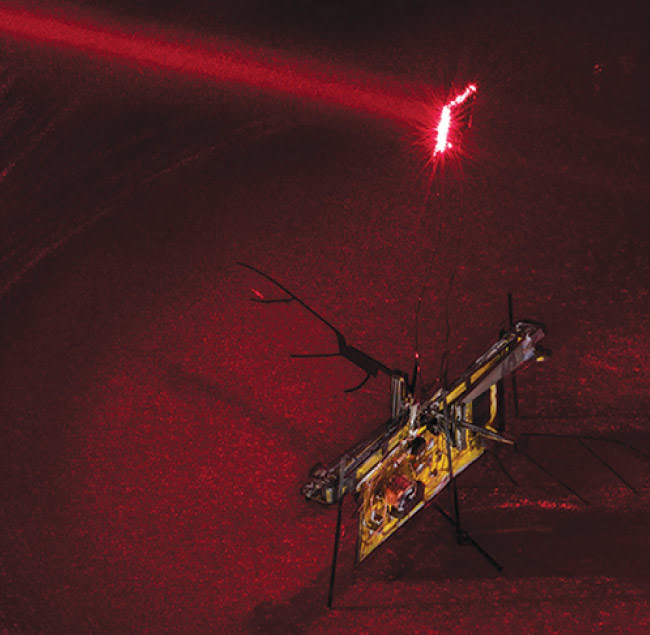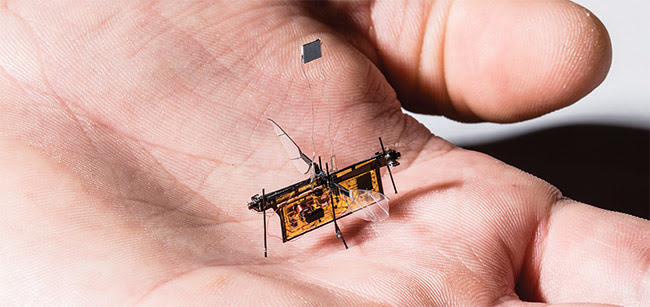Slightly heavier than a toothpick and powered by a laser beam, an insect-sized flying robot could help survey crop growth and sniff out gas leaks. These miniaturized drones, which soar by fluttering tiny wings rather than by rotating propellers, use their small size as an advantage and are fairly inexpensive to make.
RoboFly — created by researchers at the University of Washington (UW) — uses a tiny onboard circuit that converts laser energy into enough electricity to operate its wings.

To power RoboFly, the engineers point an invisible
laser beam (shown here in red laser) at a
photovoltaic (PV) cell attached above the robot.
The cell converts the laser light into electricity. Courtesy of Mark Stone/University of Washington
Previous flying roboinsects were tethered to the ground. The electronics they needed to power and control their wings were too heavy for the miniature robots to carry.
Now, UW engineers have cut the cord and added a “brain,” via microcontroller, allowing their RoboFly to take its first independent flaps.
“Before now, the concept of wireless insect-sized flying robots was science fiction,” said UW researcher and assistant professor Sawyer Fuller. “Would we ever be able to make them work without needing a wire? Our new wireless RoboFly shows they’re much closer to real life.”
The robot requires 200 to 300 mW of power for liftoff and requires a total current of 25 mA.
RoboFly’s dual-wing-flapping design is driven by two piezoelectric actuators. The wireless system uses a MH GoPower LSM-010 976-nm laser source capable of providing 10 W of optical power to the robot. However, the laser alone does not provide enough voltage to move the wings. That’s why the team designed a circuit that boosted the 7 V coming out of the MH GoPower 5S0303.4 multijunction photovoltaic (PV) cell up to the 240 V
needed for flight. The PV cell measures 2.88 × 2.95 mm and weighs 8 mg, with an additional 5 mg of wires — well within the size and weight constraints of RoboFly.

RoboFly is slightly heavier than a toothpick. Courtesy of Mark Stone/University of Washington
“The microcontroller acts like a real fly’s brain, telling wing muscles when to fire,” said Vikram Iyer, a doctoral student in UW’s electrical engineering department. “On RoboFly,” he said, “it tells the wings things like, ‘flap hard now’ or ‘don’t flap.’”
The controller sends voltage in waves to mimic the fluttering of a real insect’s wings.
“To make the wings flap forward swiftly, it sends a series of pulses in rapid succession and then slows the pulsing down as you get near the top of the wave,” said researcher Johannes James. “And then it does this in reverse to make the wings flap smoothly in the other direction.”
Currently, RoboFly can take off and land. When the PV cell is out of direct line of sight of the laser, the robot runs out of power and lands.
Iyer told Photonics Media that the team hopes to soon be able to steer the laser so RoboFly can hover and fly around.
“We hope that by enabling wireless power for these small flying robots, they’ll eventually do all kinds of things,” he said, “like carry sensors for smart farms, fly along pipelines and detect gas leaks, and more.”
RoboFly integrates a complete power electronics package that weighs a total of 104 mg, allowing the drone’s small cousin to wirelessly spread its wings and fly.